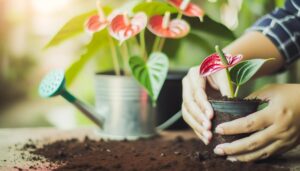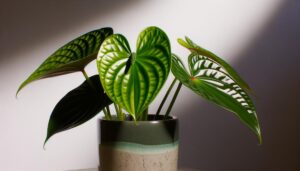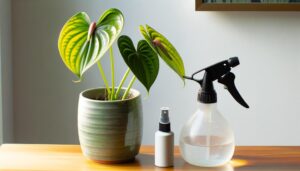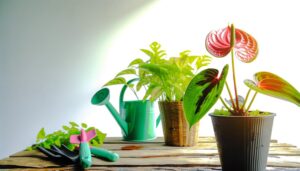Complete Guide to Anthurium Dorayaki Care
To care for Anthurium Dorayaki, place it in bright, indirect light, avoiding direct sunlight. Maintain consistent soil moisture but ensure proper drainage to prevent root rot.
Use a well-aerated mix of orchid bark, peat moss, and perlite, with a pH of 5.5 to 6.5. Keep temperatures between 65°F-80°F and humidity levels around 70-80%, using a humidifier if needed.
Check regularly for pests like spider mites and mealybugs, and address issues promptly with insecticidal soap. For detailed care instructions including humidity tips and pest management strategies, explore further.
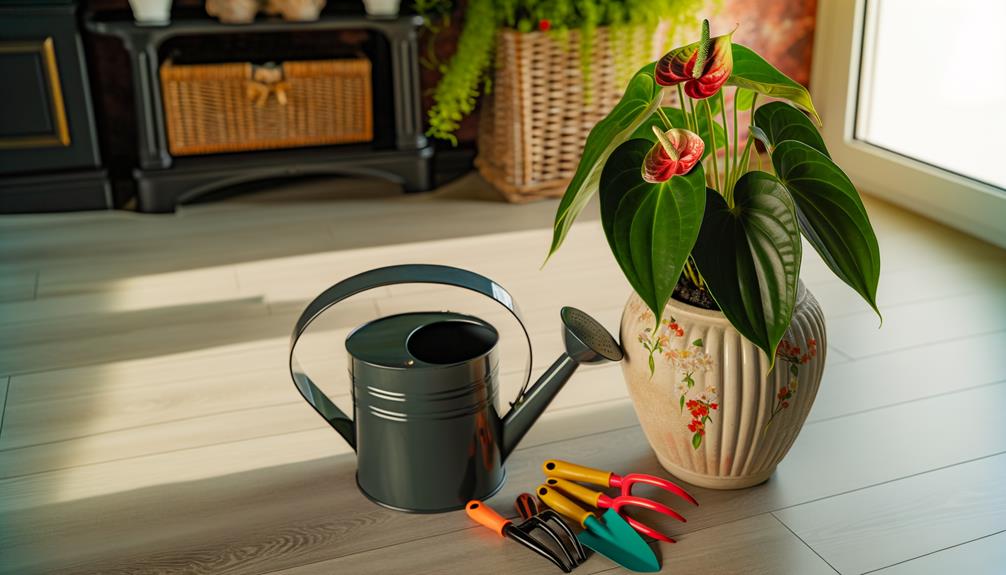
Key Takeaways
- Place Anthurium Dorayaki in bright, indirect light to avoid leaf scorching.
- Water every 5-7 days during the growing season and every 10-14 days in the dormant period.
- Use a well-aerated, loose soil mix with orchid bark, peat moss, and perlite.
- Maintain temperatures between 65°F and 80°F and humidity levels around 70-80%.
- Regularly inspect for pests like spider mites, aphids, and mealybugs, and use insecticidal soap if needed.
Ideal Lighting Conditions
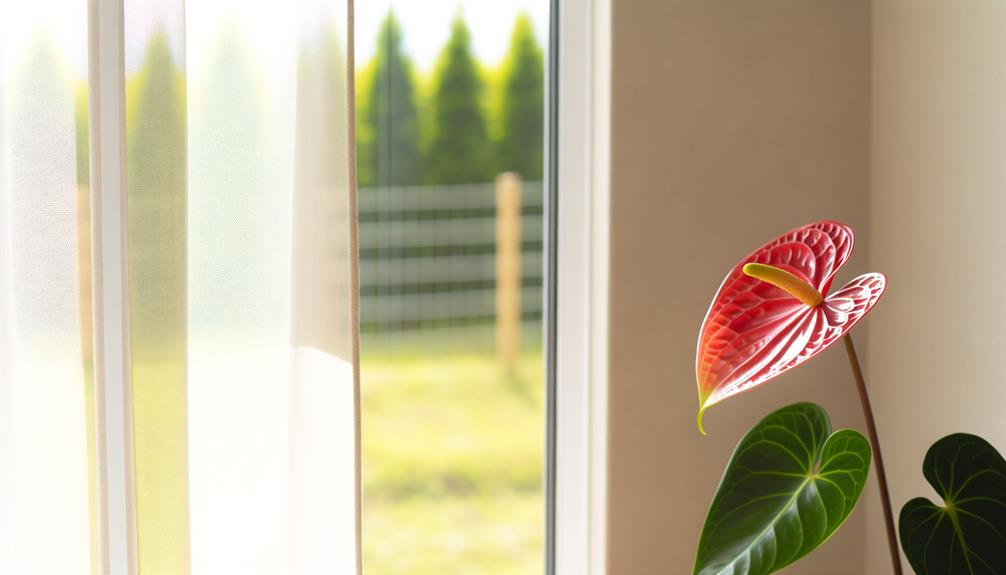
To maximize growth, place your Anthurium Dorayaki in bright, indirect light, avoiding direct sunlight which can scorch its leaves.
Ideal placement includes near an east or north-facing window where it receives diffused light. Use sheer curtains to filter any harsh rays if necessary.
Understand that insufficient light may lead to leggy growth and reduced blooming. If natural light is inadequate, consider using full-spectrum grow lights, positioning them about 12 inches from the plant to mimic natural conditions. Rotate the plant periodically to ensure uniform light exposure, promoting symmetrical growth.
Consistently monitoring light levels will help maintain vibrant foliage and prolific flowering, optimizing your Anthurium Dorayaki thrives and remains a striking centerpiece in any setting.
Watering Schedule
Maintaining the right watering schedule for your Anthurium Dorayaki involves keeping the soil consistently moist but never waterlogged, ensuring proper drainage to prevent root rot.
Water the plant when the top inch of soil feels dry to the touch. Use lukewarm, filtered water to avoid shocking the roots.
During the growing season (spring and summer), water more frequently, approximately every 5-7 days. In the dormant period (fall and winter), reduce watering to every 10-14 days.
Always allow excess water to drain completely from the pot to prevent standing water.
Regularly check the humidity levels, aiming for 60-80%, as high humidity aids in best hydration.
Adjust your watering schedule based on the plant’s specific environment and growth stage.
Soil Preferences
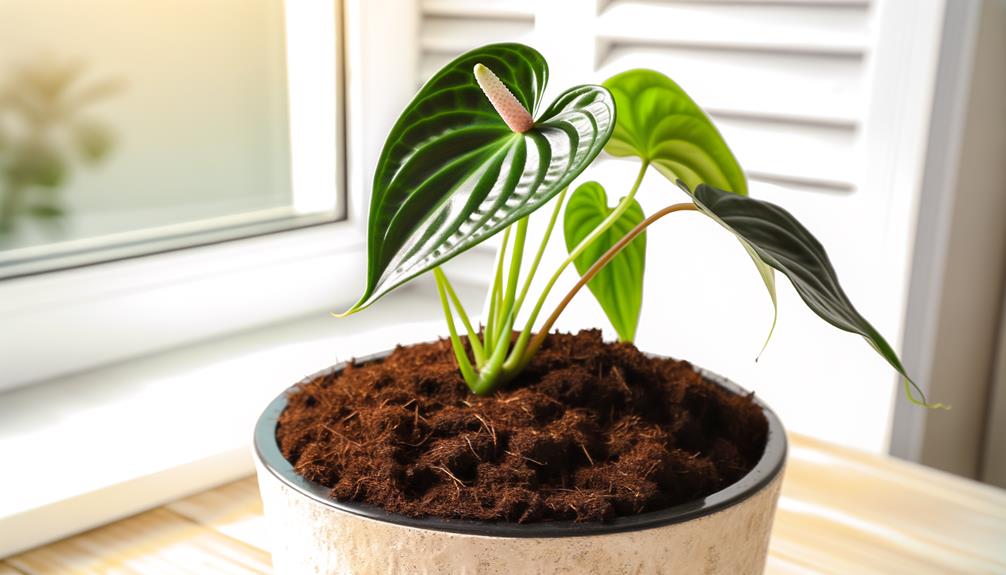
For best growth, Anthurium Dorayaki thrives in a well-aerated, loose soil mix rich in organic matter, such as a blend of orchid bark, peat moss, and perlite.
Maintain the medium retains moisture while allowing sufficient drainage to prevent root rot. Aim for a pH range of 5.5 to 6.5 to optimize nutrient uptake.
When preparing the mix, combine equal parts of orchid bark for aeration, peat moss for moisture retention, and perlite for drainage.
Regularly check the soil’s composition, as compacted soil can hinder root expansion and oxygen exchange.
To further enhance soil health, consider incorporating activated charcoal to absorb impurities and maintain freshness.
Temperature and Humidity
Maintaining ideal growth for Anthurium Dorayaki involves keeping temperatures between 65°F and 80°F, along with high humidity levels around 70-80%. To achieve this, position your plant in a warm, draft-free environment.
Use a hygrometer to closely monitor humidity levels. If necessary, increase humidity with a humidifier or by placing a tray of water near the plant.
Misting regularly with distilled water can also help, but avoid over-moistening the foliage to prevent fungal issues.
Additionally, promote good air circulation around the plant to reduce stagnant air, which can lead to rot. For the best growth, avoid sudden temperature fluctuations and keep the plant away from heating or cooling vents.
Common Pests and Diseases
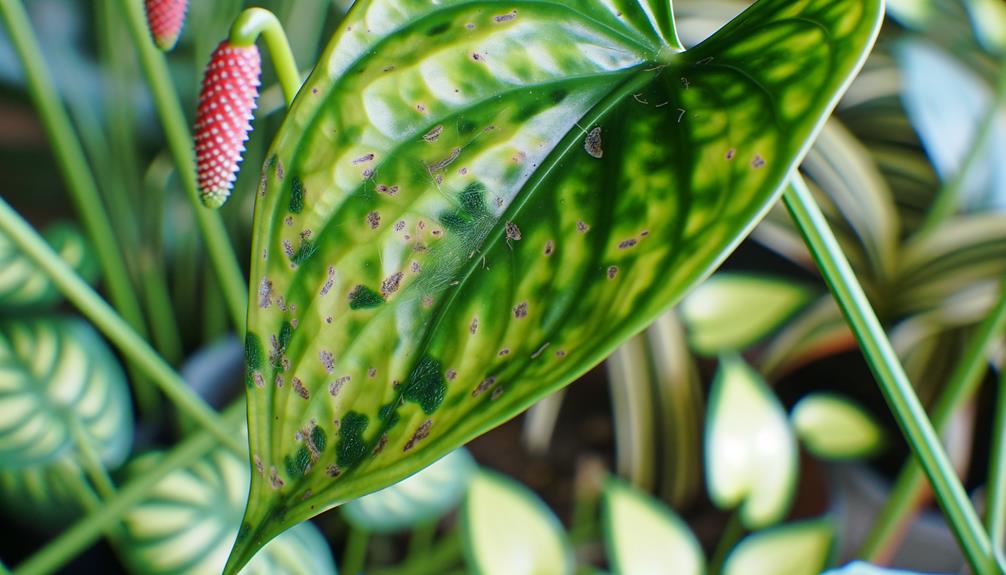
Your Anthurium Dorayaki may face threats from common pests like spider mites, aphids, and mealybugs, as well as diseases such as root rot and bacterial blight.
To combat these issues, regularly inspect the foliage for signs of infestation, such as discolored leaves or webbing. Use insecticidal soap to treat minor pest problems, guaranteeing thorough coverage on both sides of the leaves.
For root rot, guarantee proper drainage and avoid waterlogging the soil. If bacterial blight appears, identified by water-soaked lesions, remove affected leaves immediately and improve air circulation. Sterilize pruning tools between cuts to prevent pathogen spread.
Conclusion
To sum up, caring for your anthurium dorayaki involves a careful combination of consistent care and climate control.
Make sure you provide proper lighting, precise watering, suitable soil, and stable temperature and humidity.
By mastering these meticulous methods, you’ll promote perfect plant health and prevent pesky pests.
Remember, your anthurium dorayaki will flourish with focused, frequent, and faithful attention.
Happy gardening!


